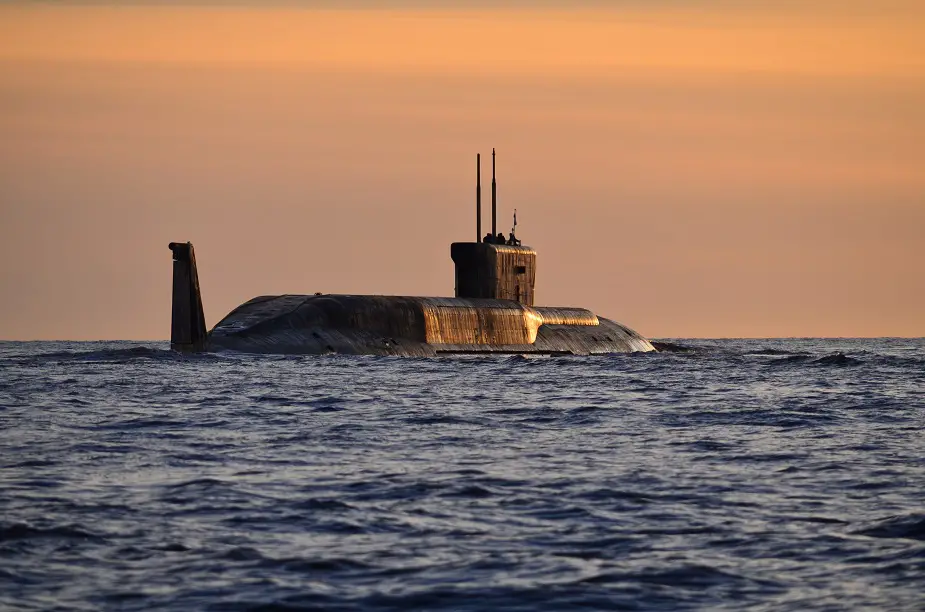Video: Russia’s SSBN Yuri Dolgorukiy Performs Salvo Launch of Bulava missiles
The Project 955 Borei-class nuclear-powered ballistic missile submarine Yuri Dolgorukiy (NATO reporting name: Dolgorukiy-class) performed a successful salvo launch of four Bulava (SS-NX-32) intercontinental ballistic missiles (ICBM) from the White Sea to hit set targets at the Kura training range in Kamchatka in Russia’s Far East. The test took place May 22, 2018.
 The K-535 SSBN "Yuri Dolgoruky" of Project 955 of the Northern Fleet on 05/20/2018. Picture by CrazyMk / forums.airbase.ru
The K-535 SSBN "Yuri Dolgoruky" of Project 955 of the Northern Fleet on 05/20/2018. Picture by CrazyMk / forums.airbase.ru
"The Project 955 lead submarine Yuri Dolgorukiy has performed a successful salvo launch of four Bulava ballistic missiles from the assigned area in the White Sea towards the Kura training range in Kamchatka," the Northern Fleet’s press office said.
The missiles were fired from the underwater position. It was the first salvo launch of four Bulava ICBMs.
"The task was accomplished. The Project 955 nuclear-powered submarine and the Bulava shipborne missile system proved their operational capabilities and reliability," the press office said. While preparing for the missile launch and accomplishing the mission, the submarine’s crew showed high maritime skills. The crew’s commander is Captain 1st Rank Vladimir Shirin.
Russian MoD video of the salvo launch
Russian Navy nuclear-powered ballistic missile submarines have performed no such salvo launches since August 1991 when the Begemot-2 operation was carried out. During the operation, the Project 667BDRM Delfin-class submarine Novomoskovsk performed a launch of 16 R-29RM (SS-N-23 Skiff) ballistic missiles. In 1998, a Project 941 nuclear-powered ballistic missile submarine (Typhoon-class) fired all of its 20 ballistic missiles. The missiles self-destructed at a low altitude shortly after they were launched as the launch was aimed at disposing of the ballistic missiles under the Strategic Arms Reduction Treaty (START).
Later on, such operations were not conducted by the Soviet/Russian Navy or foreign navies. During the Begemot-2 operation, the Project 667BDRM submarine fired only two real ballistic missiles, while the remaining 14 were mockups.
Thus, the salvo launch carried out on May 22, 2018 was record-breaking in terms of the number of real missiles launched.
The previous launch of a Bulava ICBM was carried out by the submarine Yuri Dolgorukiy from the Barents Sea on June 26, 2017. An experimental salvo launch of two Bulava missiles took place on September 27, 2016.
The Project 955 and Project 955A submarines were developed by the Rubin Central Design Bureau for Marine Engineering in St. Petersburg in northwest Russia. The Sevmash Shipyard in Severodvinsk in north Russia continues the construction of the first series of eight submarines. Three Project 955 Borei-class submarines, in particular, the lead submarine Yuri Dolgorukiy and the serial-produced submarines Alexander Nevsky and Vladimir Monomakh, have already been put into operation with the Russian Navy. The remaining five submarines, namely the Knyaz Vladimir, Knyaz Oleg, Generalissimo Suvorov, Emperor Alexander III and Knyaz Pozharsky, were laid down and are being built under improved Project 955A.
The fourth-generation Project 955 nuclear-powered submarine is designed for elimination of the enemy’s strategic land targets and for tactical missions, e.g. antisurface and antisubmarine operations, in time of war. The submarine embodies advanced shipborne radio electronics and design solutions improving the hull’s hydrodynamics and slashing the noise. The submarine’s primary weapon is the sophisticated R-30 Bulava multiple individually-targeted re-entry vehicle (MIRV) submarine-launched ballistic missile (SLBM) with a range of over 8,000 kilometers (4,971 miles). Each Project 955 submarine carries 16 solid-propellant Bulava intercontinental ballistic missiles (ICBMs). The submarine is equipped with a surfacing escape chamber for the whole crew. The submarine has a length of 170 meters, a width of 13.5 meters and a submergence depth of 450 meters. Its crew totals 107.
© Copyright 2018 TASS. All rights reserved. This material may not be published, broadcast, rewritten or redistributed.


























